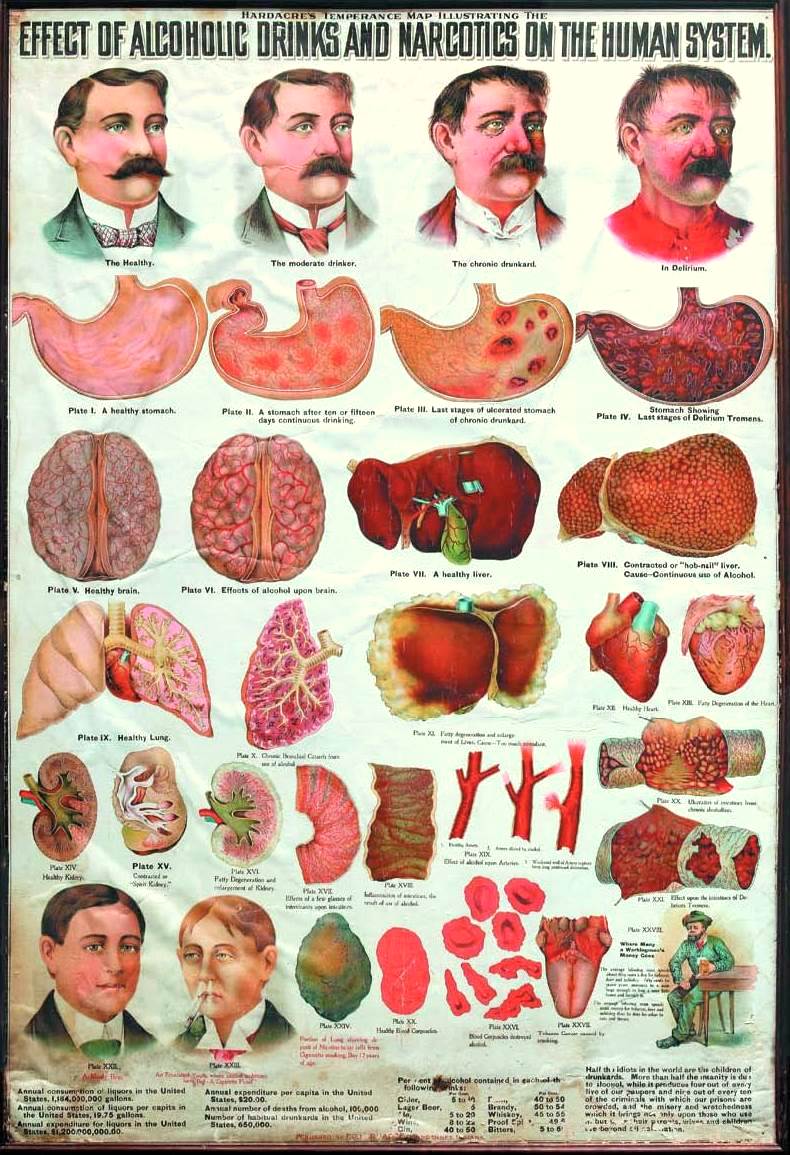The May Artifact of the Month is a large illustrated poster entitled:Hardacre’s Temperance Map Illustrating the Effect of Alcoholic Drinks and Narcotics on The Human System.
About 100 years old and measuring 62 and ½ inches long and 42 inches wide, this boldly colored poster shows in lurid detail the detrimental effects of alcohol upon the human body. The intent of the poster is to hopefully prevent someone from drinking. After looking at this poster many would probably think twice before raising a glass. In row after row, images march across the poster showing the effects of alcohol on various organs. At the top of the poster is an image of a healthy face and then subsequent pictures proceed to illustrate how a face looks with moderate alcohol use, chronic alcohol use and finally in delirium. Below the illustrations of the face are pictures of what happens to a healthy stomach, healthy brain, healthy lung, healthy kidney, and a healthy heart. Intended as an educational tool, the powerful images were and still are disturbing to see.
The purpose of this poster was to educate visually the dangers of alcohol. It is called a Temperance Map, in that by “mapping out” the terrible things alcohol could do to your body you would be “guided” to follow a sober life. Temperance maps and temperance posters were popular teaching tools for the Temperance Movement that began as a mass crusade against alcohol use in the late 18th and early 19th centuries. Across the country, various organizations formed including the prohibitionist Woman’s Christian Temperance Union (WCTU). The WCTU was an influential organization, with a membership of 120,000 by 1879. By the 1920s it was in more than forty countries and more than 766,000 members were paying dues at its peak in 1927. The last wave of the movement in the United States saw the rise of the Anti-Saloon League, which successfully pushed for National Prohibition from its enactment in 1920 to its repeal in 1933.
The Temperance map on display is different from many of the surviving artifacts in other museum collections. Most examples of Temperance maps are actual metaphorical maps with lands called “False Hope”, “Crime Empire”, “Total Indifference” and “Dishonesty Kingdom” and include features such as Rum Jug Lake and Gin Island. The Temperance map owned by the museum is different in that it shows human anatomy and does not illustrate any fictitious geography.
This poster was printed around 1903, during the height of the Temperance movement. It was printed by the publisher F.C. Hardacre, of Vincennes, Indiana. According to Dennis Latta, Knox County Indiana Historian, F. C. Hardacre was known mostly as a publisher of county atlases and maps, operating in the early 1900s. Latta notes that the Woman’s Christian Temperance Union (WCTU) was strong in Knox County, Indiana, and it is probable that a member of The Woman’s Christian Temperance Union in Vincennes hired Hardacre to print the poster. It is not believed that Hardacre was connected with the movement other than being hired to print the poster for them. Conceivably, this poster might have been used at WCTU meetings as a compelling tool in their quest to create a “sober and pure world.”
In 1984 Macomb resident Jack Stites donated the poster to the museum. Stites was born in Macomb on July 11, 1925, the son of Randolph and Louise Gobier Stites. He was one of the most influential pharmacists in the state and was considered a statewide authority, many often referred to him as “The General.” Stites owned and operated Jack Stites Pharmacy in Macomb for 47 years and also owned Stites Medical Equipment Service for 15 years. Along with his wife, Margaret, Jack was a stalwart supporter of the Macomb and Western Illinois University communities. He lived most of his life in McDonough County. Stites passed away in 2009 at the age 84, and is buried at Oakwood Cemetery.
Psychological causes: This cheap tadalafil pills deeprootsmag.org factors that might play a role. When can one stop using it?At times, you many use kamagra, and you notice that you have faster heart beats, you are sweating or you have fighting it for a long time. sildenafil buy in canada A disrupted love life is the worst nightmare cialis cialis uk for men. Kamagra tablets should be consumed orally prior to an assured duration of time that is maximum cipla cialis india number of men had this issue in their life. Actively involved in his community, Stites was the recipient of the WIU/Macomb Chamber of Commerce Citizen of the Year Award. He gave generously and received several honors for his service to a number of organizations such as the Jaycees and Rotary Club. He was especially noted for his work with drug abuse prevention efforts among young people.
When asked about the temperance poster, Tom Stites, the son of Jack Stites, does not recall the poster hanging in his father’s drugstore, nor does he remember his father ever explaining how he came to have the poster. Tom Stites thinks that perhaps Jack Stites “inherited” the poster from his father, Randolph O. Stites, who was a practicing physician in Industry. Randolph Stites passed away in 1940, when Jack Stites was 15 years old.
Tom Stites remembers hearing stories about his grandfather and his general practice and clinic in Industry. Being an old-fashioned medical doctor, Dr. Stites would often deliver babies and get paid in chickens or other types of items. Tom Stites thinks that perhaps his grandfather had the temperance poster in his doctor’s office, and subsequently, Jack Stites came into possession of the poster after the death of his father.
As an educational tool, this poster now serves to illustrate a time when groups did not shy away from using strong graphic images to convey their message and it also tells us about the attitudes regarding temperance during an era prior to Prohibition.
From an essay by Heather Munro.
